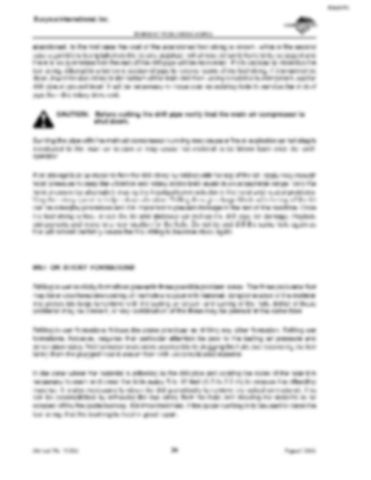BI616959
Bucyrus International, Inc. 59HR ELECTRIC BLAST HOLE DRILL
abandoned. In the first case the cost of the abandoned tool string is known, while in the second case a gamble is being taken as the bit and stabilizer will almost certainly have to be scrapped and there is no guarantee that the rest of the drill pipe will be recovered. If it is decided to abandon the tool string, attempt to unscrew a section of pipe to recover some of the tool string. If this cannot be done, lower the tool string to the bottom of the hole and then, using a suitable burning torch, cut the drill pipe at ground level. It will be necessary to move over an existing hole to remove the stub of pipe from the rotary drive unit. CAUTION: Before cutting the drill pipe verify that the main air compressor is shut down. Burning the pipe with the main air compressor running may cause a fire or explosion as hot slag is introduced to the main air stream or may cause hot material to be blown back onto the torch operator. If an attempt is to be made to free the drill string by drilling with the top of the bit, apply only enough hoist pressure to keep the vibration and rotary motor load levels in an acceptable range. Vary the hoist pressure by alternately placing the hoist/pulldown selector in the hoist and neutral positions. Vary the rotary speed to help reduce vibration. Drilling through a large block with the top of the bit can be a lengthy procedure and it is important to prevent damage to the rest of the machine. Once the tool string is free, check the bit and stabilizer as well as the drill pipe for damage. Replace components and move to a new location for the hole. Do not try and drill the same hole again as this will almost certainly cause the tool string to become stuck again.
WET OR STICKY FORMATIONS Drilling in wet or sticky formations presents three possible problem areas. The three problems that may be encountered are coating of the hole and pipe with material, conglomeration of the material into pieces too large to remove with the bailing air stream and caving of the hole. Either of these problems may be present, or any combination of the three may be present at the same time. Drilling in wet formations follows the same practices as drilling any other formation. Drilling wet formations, however, requires that particular attention be paid to the bailing air pressure and penetration rates. Wet formations are more susceptible to plugging the hole, but recovering the tool string from the plugged hole is easier than with unconsolidated material. In the case where the material is adhering to the drill pipe and coating the sides of the hole it is necessary to ream and clean the hole every 5 to 10 feet (1.5 to 3.0 m) to remove the offending material. It is also necessary to clean the drill periodically to remove the caked on material. This can be accomplished by removing the tool string from the hole and allowing the material to be scraped off by the guide bushing. It is important then, if the guide bushing is to be used to clean the tool string, that the bushing be kept in good repair.
Manual No. 10425
94
August 2006


